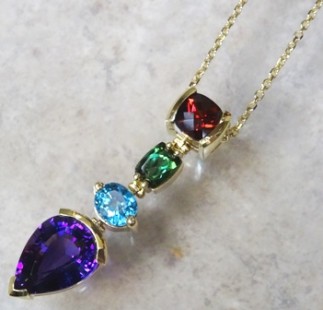
Cushion cut Imperial topaz in one of my custom platinum mountings.
What do Imperial jadeite, black opal, demantoid garnet, and alexandrite all have in common? First of all, they are all exceptionally rare gemstones. Second, they can command thousands to tens of thousands of dollars to even millions of dollars per carat. Third, they have all historically fallen under the unfortunate appellation “semi-precious” because they are colored gemstones that are not ruby, emerald, or sapphire – the “precious” stones of Antiquity that have somehow maintained their stranglehold on the usage of the word “precious.” It’s a travesty, really.
There is a growing movement in the jewelry industry to do away with the descriptor “semi-precious.” The World Jewelry Confederation (CIBJO: the ruling body of ethical quality control for most of the world in the jewelry industry) has already ruled that:
“The term semi-precious is misleading and shall not be used.” The Gemstone Book 2012-12-30 4.3.6
Even the Federal Trade Commission of the United States has tossed around banning the term in the advertising, marketing, and selling of gemstones, echoing the CIBJO in saying that the phrase is misleading and unfair.
Why is the term misleading and unfair? To call a gemstone “semi-precious” is basing the gem’s perceived value on a notion first implemented by the Ancient Greeks that was not founded upon the scientific data we now have available to us today. To the Greeks of Antiquity, ruby, emerald, and sapphire were especially prized for their rarity, colors, and beauty. That seems all well and good because top quality rubies over 10-carats are the most expensive gemstones in the world, bar none. Premier Colombian emeralds of exceptional size are not far behind them, and Kashmir blue velvet sapphires have sold for over a hundred thousand dollars per carat at auction, but only as a part of a finished piece of jewelry. In fact, sapphire is hardly the bank-buster that Imperial jadeite and alexandrite are capable of being.
One of the kickers comes when you realize that two out of the three (ruby and sapphire) are not the same as they once were. The rubies and sapphires we recognize today as corundum are colored by various impurities. These minerals were likely unknown to Western Civilization until about the 4th Century BC, perhaps even later. The Greek words translated into English as “ruby” and “sapphire” are, respectively, “sardius” and “sappheiros.” Sardius has been proven to refer to carnelian, which was largely available from mines around a town called Sardius. Sappheiros, more than likely, referred to lapis lazuli. The point is: the “precious” stones are not exactly the “precious” stones they once were. Carnelian and lapis lazuli fall squarely into the “semi-precious” concept of today.

MSA Custom 4-stone color pendant
Another consideration for the classical “precious” stones was their rarity. Back then as now, rarity most certainly applies to ruby, emerald, and sapphire. However, the notion that they are still the rarest of the rare is utterly erroneous. Fine red spinel is rarer than fine ruby. Tsavorite garnet has only been found in three locations, while emeralds are still being dug up in multiple localities on three continents. And gem quality brilliant blue benitoite has only been found in one place in the entire world (San Benito County, California, USA), while gemmy blue sapphire is mined at multiple mines in at least ten countries.
So why not just expand the “precious” stone list to include things like red beryl, benitoite, and Paraiba tourmaline? Wouldn’t graduating the newly recognized magnificence of the ultra-rare musgravite still leave the truly lowly like generic garnets and aquamarines where they belong? Not exactly.
Colored gemstones are graded on a fairly qualitative scale. A top quality rubellite tourmaline will easily sell for more than a low- to even mid-grade emerald of the same size. Which one is more precious?
But change the circumstances: your grandfather gifted you your grandmother’s prized small, slightly chipped opal ring. Will that be more precious to you than a fine ruby sitting on an auction block with a seven-figure price tag?
So the real problem hinges on the abstract definition of the word “precious.” “Semi-precious” is unfair and misleading. I say it’s time to give respect where it’s due. All gemstones are precious, although the eye of the beholder is the ultimate judge. People wear the jewelry they do because they like it. Those things are precious to them. I design jewelry the way I do because I think it’s beautiful. Those things are precious to me.
I’m known for colored gemstones. I keep quite a variety on hand. If you’re still leery of how a topaz can warrant more financial commitment than an emerald, stop by to see me, and I’ll reveal the beauty of it all to you.
Tags: garnet, gemstones, jewelry industry, lapis lazuli, red spinel, rubies, ruby